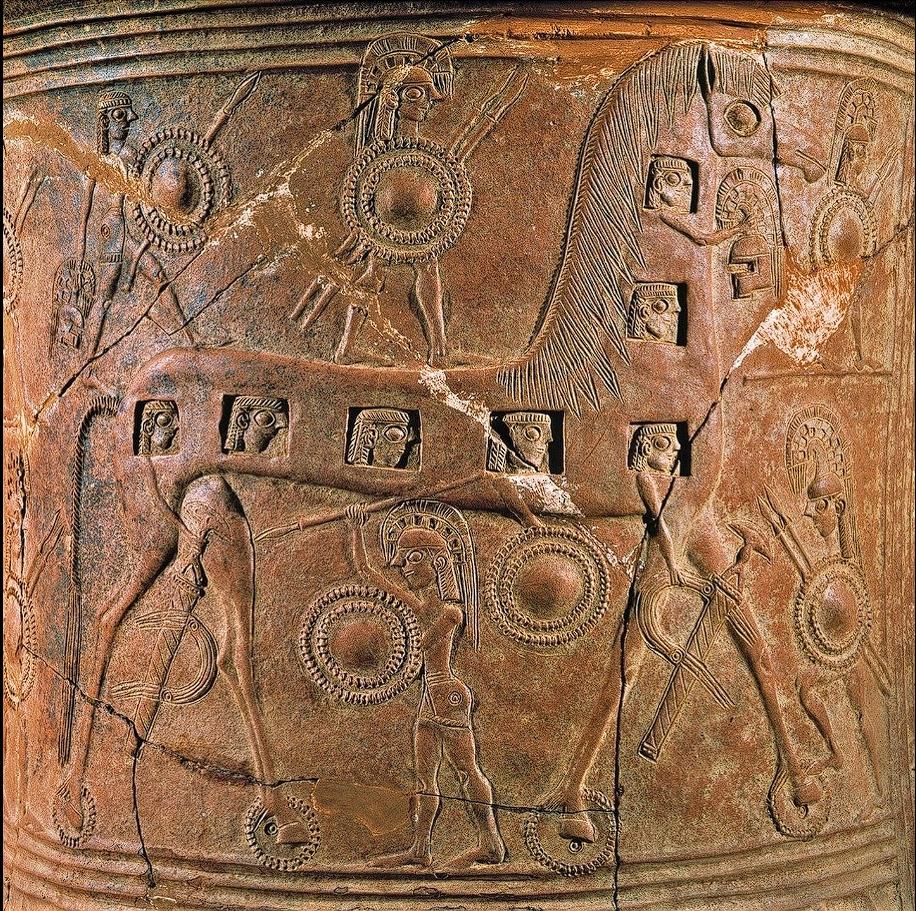Unearthed on the sun-drenched island of Mykonos, a remarkable 2,700-year-old amphora has seized the attention of historians and art enthusiasts worldwide. Reverently known as the Mykonos Vase, this terracotta masterpiece is dated to approximately 670 BCE and stands as a significant archaeological find, representing one of the earliest known visual depictions of the legendary Trojan War within the realm of Greek art. Its discovery offers an invaluable glimpse into the ancient world’s artistic techniques and cultural preoccupations.
A Vivid Depiction of Troy’s Fall: Bringing Ancient Narratives to Life
What truly distinguishes the Mykonos Vase and elevates it to a position of historical significance is its extraordinarily vivid portrayal of the dramatic Sack of Troy. Across the curved expanse of its terracotta surface, meticulously crafted rows of black-figure illustrations spring to life, offering a dynamic narrative of the epic conflict. Greek warriors are depicted forcefully breaching the formidable walls of the besieged city, valiant Trojan defenders are shown falling amidst the chaos of battle, and the ensuing pandemonium of the city’s collapse is powerfully conveyed through the artistic rendering.
The Earliest Visual Representation of the Trojan Horse
Among the multitude of figures adorning the vase, a particularly striking detail commands attention: a meticulously rendered wooden horse, conspicuously filled with armed Greek soldiers. This depiction stands as one of the earliest known visual representations of the ingenious and ultimately decisive ruse employed by the Greeks to infiltrate the seemingly impenetrable city of Troy. Its presence on the vase underscores the enduring power and early dissemination of this pivotal episode from the Trojan War narrative.
Scenes of Breaching Walls and Fallen Warriors
The narrative bands encircling the Mykonos Vase are alive with the dynamic action of the Trojan War’s final moments. The artist skillfully captures the intensity of the siege, depicting Greek warriors engaged in fierce combat as they overcome Troy’s defenses. Alongside these scenes of conquest, the vase also portrays the tragic reality of war, with fallen Trojan warriors rendered in poignant detail, highlighting the human cost of this legendary conflict. These illustrations offer a powerful visual complement to the epic poems that recounted these events.
Capturing the Chaos of the Sack of Troy
Beyond the specific scenes of breaching walls and fallen combatants, the overall composition of the Mykonos Vase effectively conveys the widespread chaos that ensued during the Sack of Troy. The arrangement of figures, the dynamism of their poses, and the overall energy of the illustrations combine to create a sense of turmoil and destruction. This artistic rendering provides a tangible representation of the epic scale and devastating consequences of the city’s fall, as described in ancient literary sources.
The Orientalizing Period: A Fusion of Artistic Influences
The Mykonos Vase is a product of the Orientalizing period in Greek art, a transformative era characterized by a significant absorption of artistic motifs and stylistic elements from the Near East. This period witnessed a departure from the more rigid and abstract patterns of the preceding Geometric style, with Greek artists increasingly embracing more fluid, narrative-driven imagery and incorporating exotic decorative elements into their work. The Mykonos Vase beautifully exemplifies this artistic transition.
A Shift from Geometric to Narrative Imagery
Prior to the Orientalizing period, Greek art, particularly during the Geometric style, was characterized by its emphasis on abstract geometric patterns and stylized representations. The Mykonos Vase marks a clear departure from this tradition, showcasing a move towards more naturalistic and narrative-focused depictions. The detailed illustrations of human figures and the dynamic scenes from the Trojan War exemplify this shift in artistic priorities, where storytelling became a central element of visual expression.
Absorption of Near Eastern Motifs
The Orientalizing period was marked by increased contact and cultural exchange between Greece and the Near East, leading to the adoption of various artistic motifs and techniques. While the narrative content of the Mykonos Vase remains distinctly Greek, the decorative bands and certain stylistic elements may reflect these Near Eastern influences, showcasing the interconnectedness of ancient Mediterranean cultures and the cross-pollination of artistic ideas.
Reflecting a Deep Cultural Fascination with Myth and War
The craftsmanship evident in the Mykonos Vase not only reveals the artistic skill of its creator but also underscores a deep cultural fascination within ancient Greek society with the powerful themes of myth, war, and legacy. The choice to depict the Sack of Troy, a pivotal event in their legendary past, highlights the importance of these narratives in shaping Greek identity and collective memory. The vase serves as a tangible link to the epic tales that formed the bedrock of their cultural understanding.
A Timeless Tale in Terracotta: Housed in Mykonos
Now carefully preserved and housed in the Archaeological Museum of Mykonos, the Mykonos Vase continues to eloquently tell its compelling story to modern audiences. This ancient terracotta artifact serves as an invaluable window into a world where powerful myths and enduring memories played a crucial role in shaping the identity and cultural understanding of a burgeoning civilization. Its intricate illustrations offer a direct connection to the artistic sensibilities and narrative preoccupations of the ancient Greeks, ensuring that the echoes of Homeric poetry, etched into clay millennia ago, continue to resonate today.

CÁC TIN KHÁC
Mary Walton: The Forgotten Inventor Who Helped Clean Up America’s Cities
Tomb of Queen Nefertari in the Valley of the Queens, Egypt
Discover the Hypostyle Hall of the Temple of Hathor at Dendera
Venus de Losange: Unveiling the Mystery of a 20,000-Year-Old Paleolithic Icon